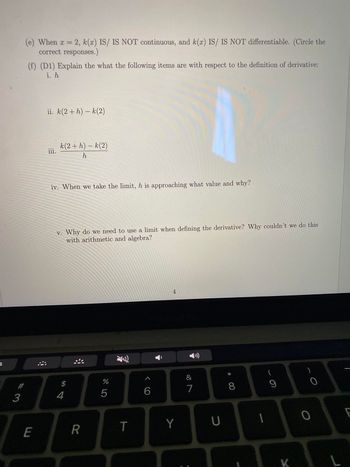3. L7: I can compute average rates of change and find slopes of secant lines. D1: I can explain the purpose of each symbol in the limit definition of derivative. I can illustrate each part of the definition graphically and explain the role of the limit. D5 I can use the limit definition of the derivative to determine the differentiability of a function at a point. Use k(x) = -2x + 6 -2x+5 x < 2 x ≥ 2 to answer the following questions.
3. L7: I can compute average rates of change and find slopes of secant lines. D1: I can explain the purpose of each symbol in the limit definition of derivative. I can illustrate each part of the definition graphically and explain the role of the limit. D5 I can use the limit definition of the derivative to determine the differentiability of a function at a point. Use k(x) = -2x + 6 -2x+5 x < 2 x ≥ 2 to answer the following questions.
Calculus For The Life Sciences
2nd Edition
ISBN:9780321964038
Author:GREENWELL, Raymond N., RITCHEY, Nathan P., Lial, Margaret L.
Publisher:GREENWELL, Raymond N., RITCHEY, Nathan P., Lial, Margaret L.
Chapter4: Calculating The Derivative
Section4.CR: Chapter 4 Review
Problem 5CR: Determine whether each of the following statements is true or false, and explain why. The chain rule...
Related questions
Question

Transcribed Image Text:3. L7: I can compute average rates of change and find slopes of secant lines.
D1: I can explain the purpose of each symbol in the limit definition of derivative. I can illustrate
each part of the definition graphically and explain the role of the limit.
D5 I can use the limit definition of the derivative to determine the differentiability of a function
at a point.
Use k(x) =
-2x + 6
-2x + 5
x < 2
x ≥ 2
to answer the following questions.

Transcribed Image Text:H
#3
3
(e) When x = 2, k(x) IS/ IS NOT continuous, and k(x) IS/ IS NOT differentiable. (Circle the
correct responses.)
(f) (D1) Explain the what the following items are with respect to the definition of derivative:
i. h
E
ii. k(2+h)-k(2)
iii.
k(2+h)-k(2)
h
iv. When we take the limit, h is approaching what value and why?
v. Why do we need to use a limit when defining the derivative? Why couldn't we do this
with arithmetic and algebra?
4
R
%
5
秋
T
A
6
4
Y
())
&
7
U
8
(
9
0
C
1
0
K
E
Expert Solution
This question has been solved!
Explore an expertly crafted, step-by-step solution for a thorough understanding of key concepts.
This is a popular solution!
Trending now
This is a popular solution!
Step by step
Solved in 3 steps with 2 images

Follow-up Questions
Read through expert solutions to related follow-up questions below.
Follow-up Question
Answer is not correct, my question is different,

Transcribed Image Text:H
#3
3
(e) When x = 2, k(x) IS/ IS NOT continuous, and k(x) IS/ IS NOT differentiable. (Circle the
correct responses.)
(f) (D1) Explain the what the following items are with respect to the definition of derivative:
i. h
E
ii. k(2+h)-k(2)
iii.
k(2+h)-k(2)
h
iv. When we take the limit, h is approaching what value and why?
v. Why do we need to use a limit when defining the derivative? Why couldn't we do this
with arithmetic and algebra?
4
R
%
5
秋
T
A
6
4
Y
())
&
7
U
8
(
9
0
C
1
0
K
E

Transcribed Image Text:3. L7: I can compute average rates of change and find slopes of secant lines.
D1: I can explain the purpose of each symbol in the limit definition of derivative. I can illustrate
each part of the definition graphically and explain the role of the limit.
D5 I can use the limit definition of the derivative to determine the differentiability of a function
at a point.
Use k(x) =
-2x + 6
-2x + 5
x < 2
x ≥ 2
to answer the following questions.
Solution
Recommended textbooks for you

Calculus For The Life Sciences
Calculus
ISBN:
9780321964038
Author:
GREENWELL, Raymond N., RITCHEY, Nathan P., Lial, Margaret L.
Publisher:
Pearson Addison Wesley,


Trigonometry (MindTap Course List)
Trigonometry
ISBN:
9781337278461
Author:
Ron Larson
Publisher:
Cengage Learning

Calculus For The Life Sciences
Calculus
ISBN:
9780321964038
Author:
GREENWELL, Raymond N., RITCHEY, Nathan P., Lial, Margaret L.
Publisher:
Pearson Addison Wesley,


Trigonometry (MindTap Course List)
Trigonometry
ISBN:
9781337278461
Author:
Ron Larson
Publisher:
Cengage Learning


Glencoe Algebra 1, Student Edition, 9780079039897…
Algebra
ISBN:
9780079039897
Author:
Carter
Publisher:
McGraw Hill

Algebra & Trigonometry with Analytic Geometry
Algebra
ISBN:
9781133382119
Author:
Swokowski
Publisher:
Cengage